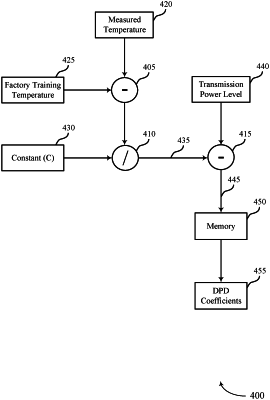| CPC H04W 52/36 (2013.01) [H04B 1/0475 (2013.01); H04B 1/62 (2013.01); H04W 72/0473 (2013.01); H04B 2001/0425 (2013.01)] | 30 Claims |

|
1. A method for wireless communication at a user equipment (UE), comprising:
determining a power offset value based at least in part on a first temperature value associated with a training procedure for the UE, a second temperature value associated with the UE, and a constant value, wherein the training procedure is associated with a plurality of sets of coefficients for the UE;
applying the power offset value to a transmission power level for transmission of a message to obtain a first transmission power level;
determining a set of coefficients of the plurality of sets of coefficients based at least in part on the training procedure and the first transmission power level; and
applying the set of coefficients to a digital pre-distortion engine of the UE to generate the message.
|